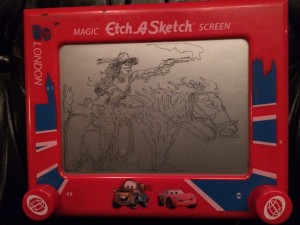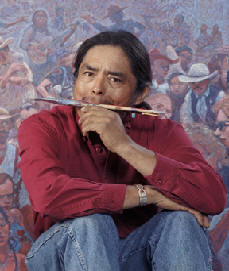 They rode hard with intensity upon their Palomino steed. They sat in their saddles with confidence, synchronized as they moved through brushes and deadfalls. The Horse and his Cowboy. They were overwhelming there up on the movie screen. Their hats disturbed not in the slightest by the wind they often rode into. They squinted hard and narrow into the storm and at their adversaries. Their six-guns blazed easily from their gloved hands. I saw bad men falling by the wayside as our screen Cowboy again evened the scale of Justice. The dusty and gritty lines from a dying cowboy I heard were repeated into the unrelenting heat of then Upper Sonoran Desert. The cool ways they sauntered into the saloons to eject troublemakers were repeated much later.
They rode hard with intensity upon their Palomino steed. They sat in their saddles with confidence, synchronized as they moved through brushes and deadfalls. The Horse and his Cowboy. They were overwhelming there up on the movie screen. Their hats disturbed not in the slightest by the wind they often rode into. They squinted hard and narrow into the storm and at their adversaries. Their six-guns blazed easily from their gloved hands. I saw bad men falling by the wayside as our screen Cowboy again evened the scale of Justice. The dusty and gritty lines from a dying cowboy I heard were repeated into the unrelenting heat of then Upper Sonoran Desert. The cool ways they sauntered into the saloons to eject troublemakers were repeated much later.
I echoed those lines out into the sage flats and canyon walls. I want to feel my screen hero’s passion in mouthing those lines. We tendered that sense of compassion and our budding masculinity. I wanted to be that cowboy with the blazing shiny six-guns. I longed for the wind to ride into, to rebel against. I wanted that starched western shirt as tailored for my screen heroes. I believe we all shared in that longing as little brown boys on the harsh grounds of the government boarding school. We all were in need of a screen hero—the only ones we were aware of and had access to were on the silver screen. We all had bad guys robbing us of our confidence. Some were spiritual for us, some were institutional bullies.
At home during the summer, we rode our horses hard into the gritty sand storm of Klethla Valley. We had seven riding horses and several you just took a chance on. Upon my oiled old saddle, tooled and stamped with its origin, DeBerge’s Saddle Shop in Williams. I rode enveloped in the aroma and the sounds of squeaking leather. Sitting as tall as I could muster, I shot cap guns unsheathed from a tooled holster tied to my thigh—harsh on the ears it sounded. I visualized bad guys tumbling backward into the path of my horse. These were “Ye’naa ghaii”: Skinwalking bank robbers of the spirits. I visualized fair maidens somewhere needing untying. I visualized a sidekick who second guesses me. I rode hard across the hot valley leading a trail of dust that screen cowboys often do. In my tattered shirt and straw hat I rode, jackrabbits and straying sheepdogs cleared the path ahead where my invisible quarry rides. These were the easy days of youth when dreams seemed so accessible and all life was a stage. My horse seemed to know this. So, on we rode, as our own hero and all else, cameos.
Once, I mistook my brother Nelson for a bad guy in our impromptu cowboy games on horseback. He was upon his palomino, and I upon my bay mare. Riding across waves of sand dunes I roped him with a blow to the shoulders, rendering his arms helpless. I plowed to a stop and yanked him off his horse. I dragged him across a field of sand dunes and snakeweeds before I realized that he was Nelson, not Nosey Calhoun. On another occasion, I tried to drown him in four inches of stock pond water. We were fighting Indians in some remote swampland. He managed to rise up in real anger, but I was already upon my horse while he was still spitting out water. He managed to even out the score later by inadvertently forgetting to tighten my cinches for me. Seeing the dizzying world all about you beneath the belly of your horse was a lesson I never repeated.
At times, my other brothers and cousins would join and we had us a posse to chase down straying livestock. I always chased bad guys. An odd assemblage of young boys in characters riding as one across the valley was enough to put any outlaws on the lam. There was a sense of unrealness to this whole antic of our screen cowboy heroes, but safe and almost sanitary. There were no overt splattering of blood before Sam Peckinpah. When “shot,” we let out a stream of Dineh’ expletives and fell convincingly off our steeds. Our allies jumped off their horses, touch-rubbed your wounds and you were good to go again.
We played dangerous games mimicking our screen Cowboy heroes. It was in one gullible moment in my youth that I walked a length of glowing ember. I could not walk for five weeks as I stayed on piñon pitch medicine therapy. Miraculously, I never broke a bone. I just ran out of my roll of caps for my pistol. Later, I lived vicariously through another media: comic books.
Ridding the town of bad guys was our sense of duty and it was even justifiably comfortable. Another town breathing easier, maidens rescued and animals fed. I was 11 years old and meek otherwise. I was my hero there upon my horse. My brother was my sidekick, maybe it was the other way around. Either way, we rode into the setting sun often with the credits rolling in our minds.
A professional artist since 1983, Shonto Begay spends his time painting, writing and speaking to audiences of all ages. With an Associates of Fine Art degree from the Institute of American Indian Arts in Santa Fe, N.M. and a Bachelor of Fine Arts degree from California College of Arts and Crafts, his artwork has been featured in more than 50 shows in galleries and museums across the country.

